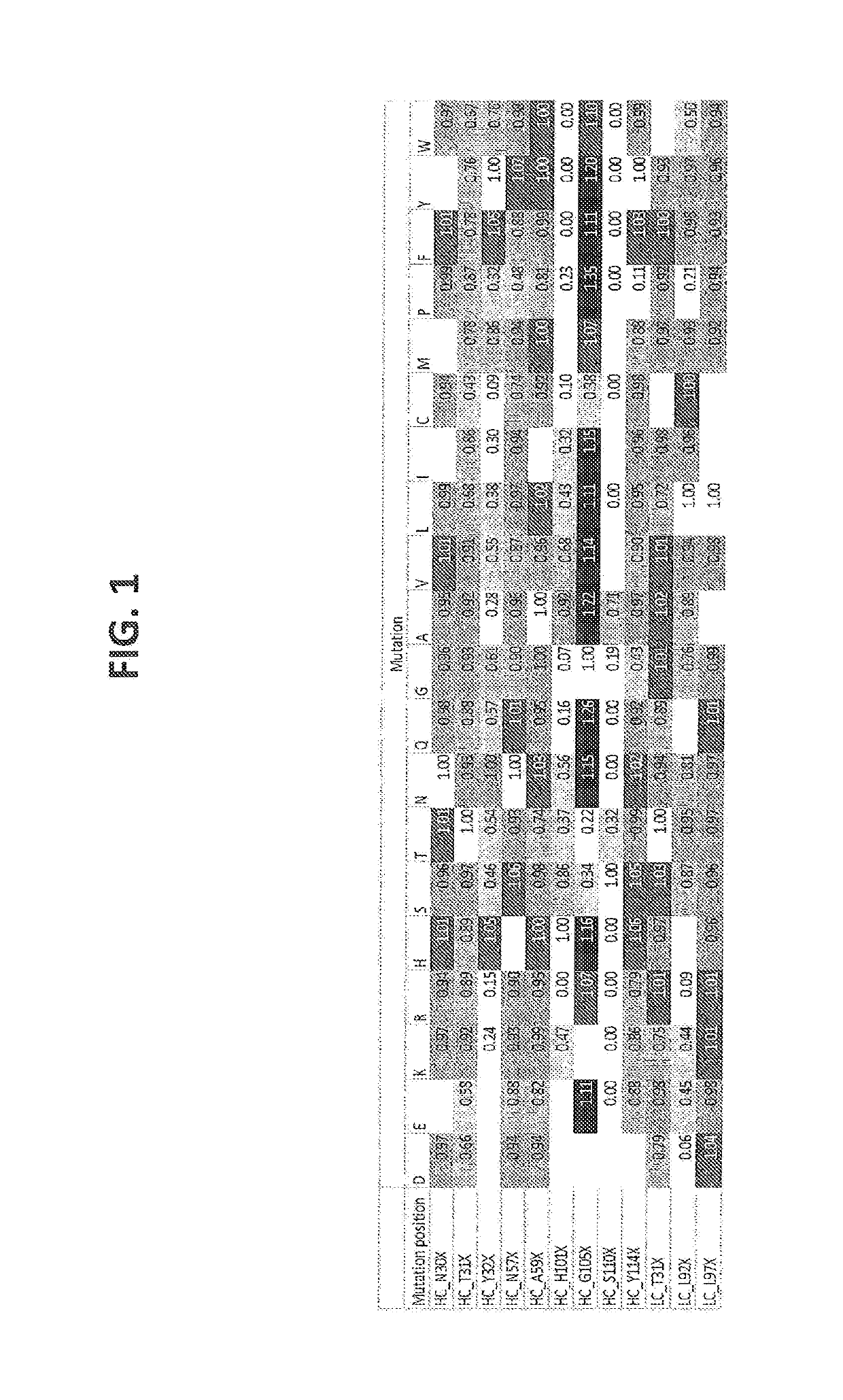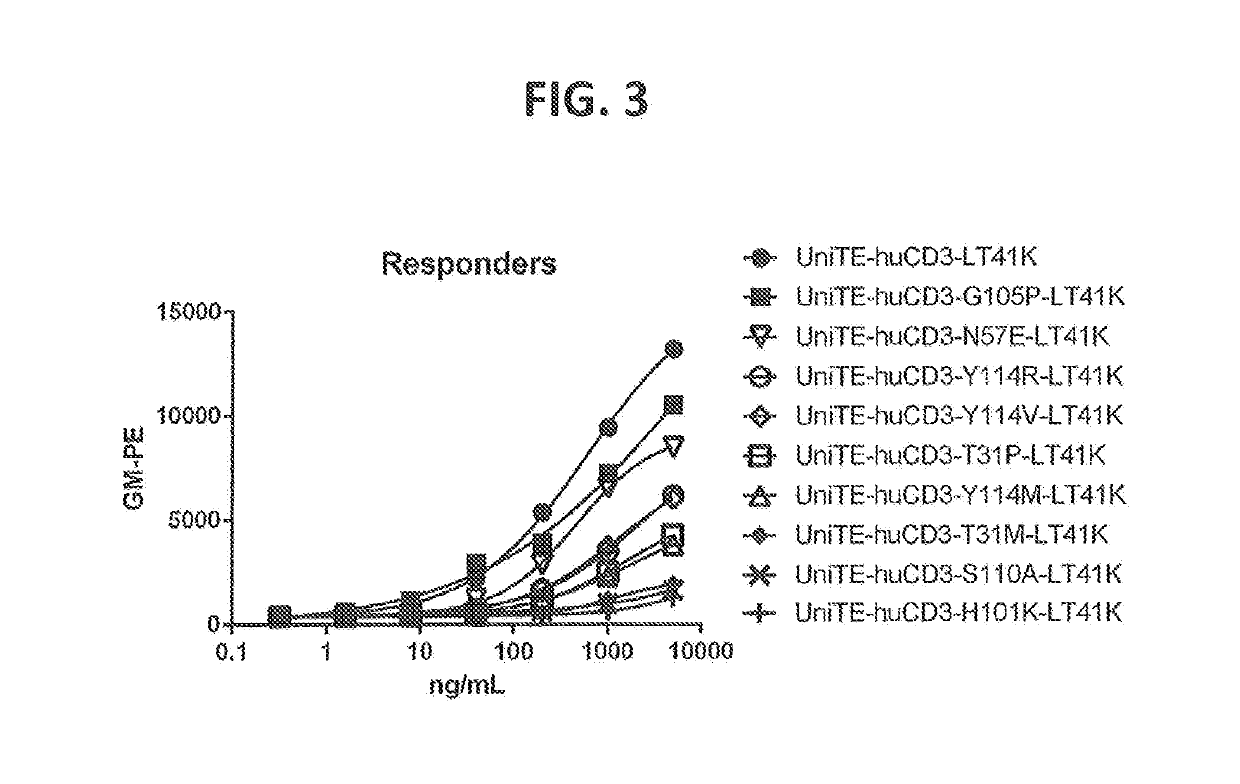Humanized or chimeric cd3 antibodies
a chimeric or humanized technology, applied in the field of humanized or chimeric antibodies, can solve the problems of immunogenic mouse/rat hybrids, low efficacy, and disappointing initial clinical studies, and achieve the effect of reducing binding affinity and same cytolytic activity
- Summary
- Abstract
- Description
- Claims
- Application Information
AI Technical Summary
Benefits of technology
Problems solved by technology
Method used
Image
Examples
example 1
n of Humanized CD3 Antibodies and Non-Activating Antibody Variants
Humanization of CD3 Antibodies
[1025]Humanization of a murine CD3 antibody (U.S. Pat. No. 8,236,308, described herein as IgG1-CD3) was performed by Antitope (Cambridge, UK) using their improved version of the germline humanization (CDR-grafting) technology (EP 0 629 240). Using this technology, 1 different VH chain (SEQ ID NO:4) and 2 different VL chains (SEQ ID NO:8, 10) were designed. By combining these 1 VH with the 2 VL chains, 2 different antibodies were generated. The humanized variants are described herein as huCD3. Thus, humanized variants comprising a VH and a VL according to the invention, are described as, e.g., IgG1-huCD3-H1L1 meaning that said specific variant is of the IgG1 isotype, is a humanized CD3 and comprises the VH amino acid sequence termed “H1” and is defined according to SEQ ID NO:4, and the VL amino acid sequence termed “L1” and is defined according to SEQ ID NO: 8. Thus, H1 refers to the varia...
example 2
[1030]Point mutations were generated by random mutagenesis performed using the Quick change mutagenesis kit (Stratagene, according to the manufacturer's instructions and the HC (p33HGTE-huCD3-H1) and LC (p33L-huCD3-L1-T41K) expression plasmids as templates. The HC plasmid encodes for the monovalent UniBody-TE format as described in WO2011110642. Each selected position was randomized by using primers containing a NNS codon at the selected position (N=G, A, T or C and S=G or C). Mutant libraries were transformed to OneShot DH5alpha (Invitrogen) according to manufacturer's instructions.
[1031]Colony Picking and LEE PCR
[1032]For each mutated position 96 clones were individually picked into 50 μL LEE (linear expression element) PCR buffer (5 μL 10× AccuPrime PCR buffer 1, 44.6 μL water (B. Braun), 0.1 μL CMV P f (MARS) and 0.1 μL Tk pA r (MARI.) primers (100 μM stock), 0.2 μL Accuprime Taq (Invitrogen) to amplify the expression cassette from the expression plasmid (prom...
example 3
n of Mutant Library and IqG Quantification
[1034]Of each mutant (12×96 in total) 1.11 μL HC and 1.11 μL LC LEE PCR product were diluted in 2.78 μL water. The 5 μL DNA dilution was used to transfect a single well in a 96 well plate.
[1035]Per well 0.4 μL ExpiFectamine™ 293 (Invitrogen, US) and 4.6 μL Opti-MEM (Gibco, US) were mixed and incubated for 5 minutes at room temperature. Next, the Fectin / Opti-MEM mix was added to the 5 μL DNA dilution and incubated for 30 minutes at room temperature. Finally, 8.3 μL of the Fectin / Opti-MEM / DNA mix was added to 117.5 μL Expi293F™ cells. During all procedures, the plates with Expi293F™ cells were shaken to keep the cells in suspension. After transfection, cells were incubated at 37° C. / 8% CO2 for 5 days.
[1036]Five days post transfection, the supernatant was harvested. Antibody concentration in supernatant was measured by BioLayer Interferometry using the Octet RED (ForteBio, US).
PUM
| Property | Measurement | Unit |
|---|---|---|
| Fraction | aaaaa | aaaaa |
| Fraction | aaaaa | aaaaa |
| Fraction | aaaaa | aaaaa |
Abstract
Description
Claims
Application Information
 Login to View More
Login to View More - R&D
- Intellectual Property
- Life Sciences
- Materials
- Tech Scout
- Unparalleled Data Quality
- Higher Quality Content
- 60% Fewer Hallucinations
Browse by: Latest US Patents, China's latest patents, Technical Efficacy Thesaurus, Application Domain, Technology Topic, Popular Technical Reports.
© 2025 PatSnap. All rights reserved.Legal|Privacy policy|Modern Slavery Act Transparency Statement|Sitemap|About US| Contact US: help@patsnap.com



